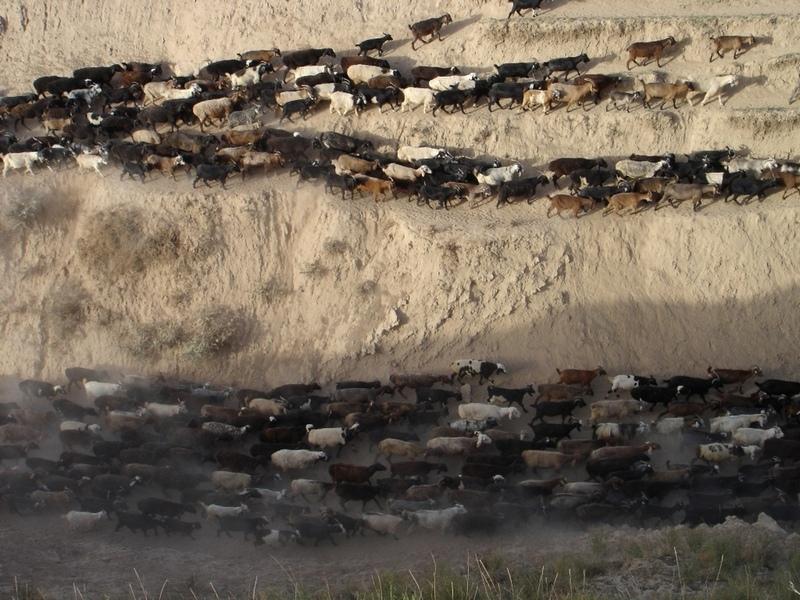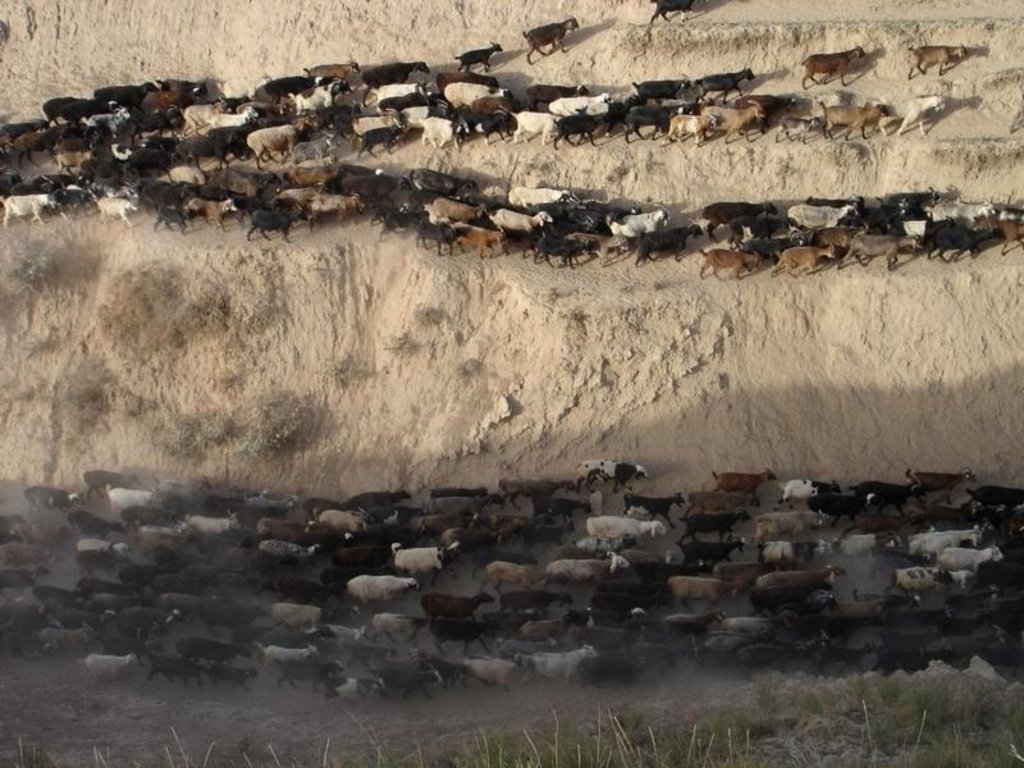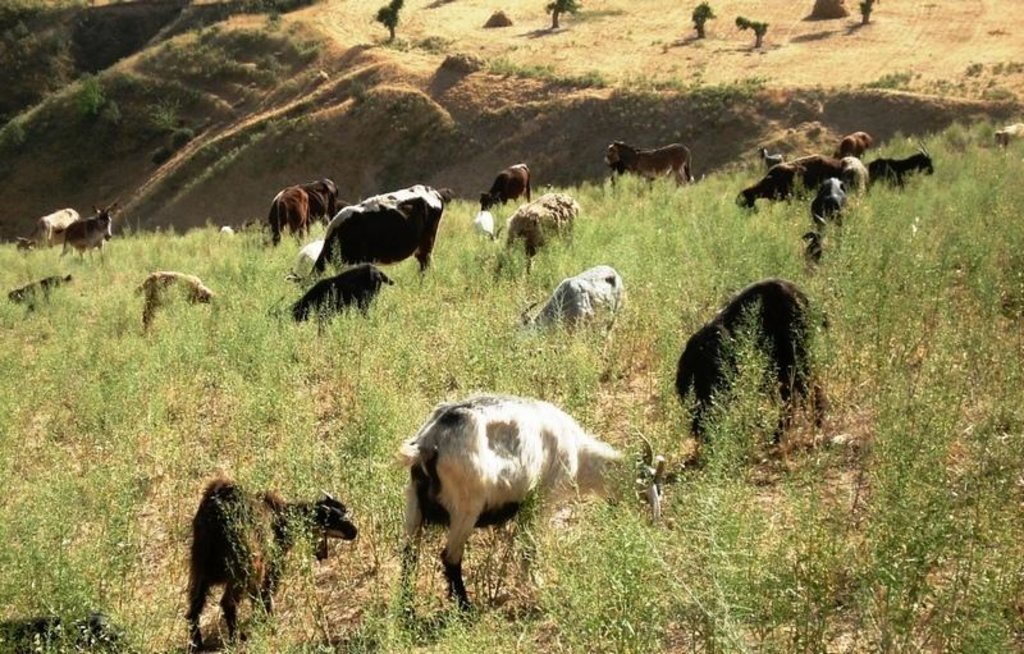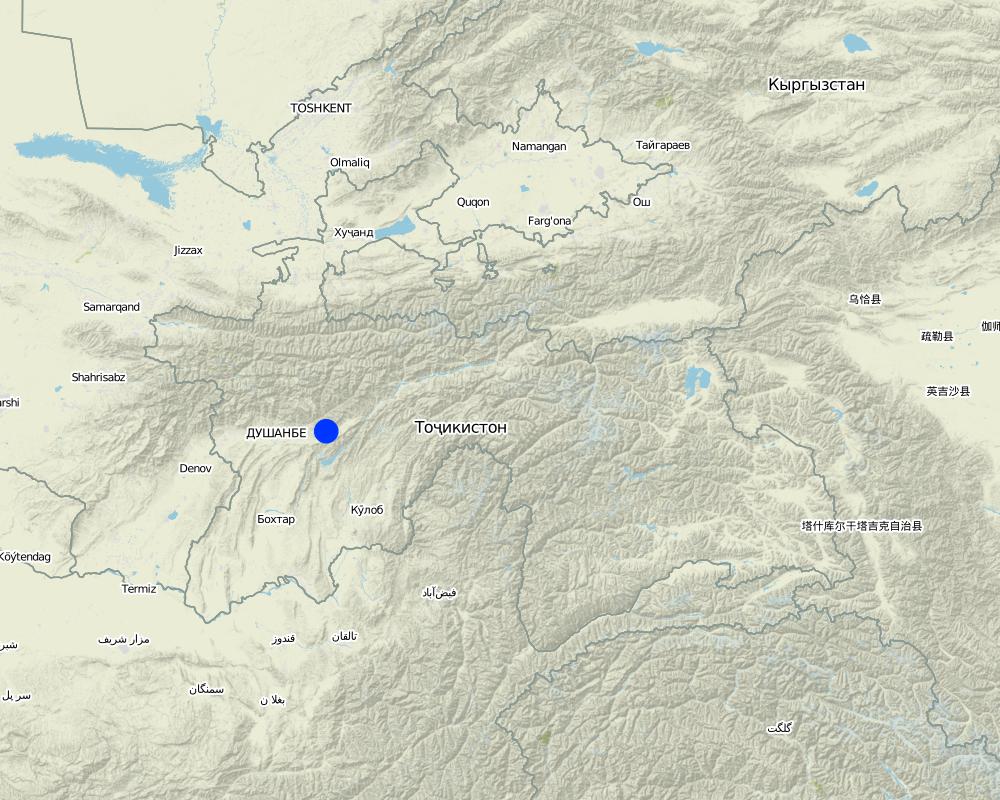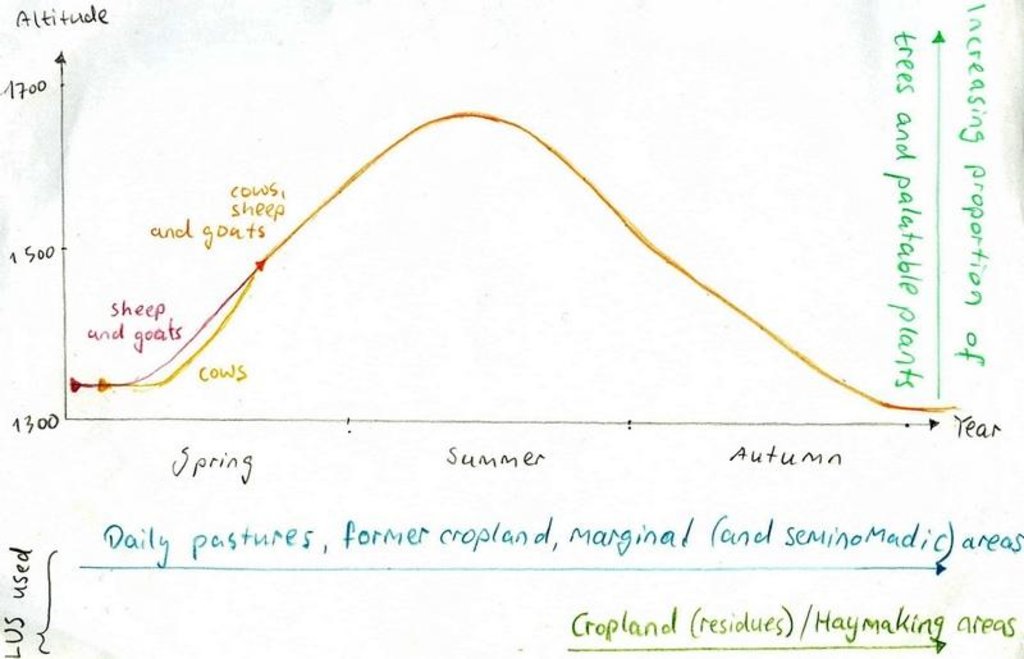Daily grazing of village-herds [塔吉克斯坦]
- 创建:
- 更新:
- 编制者: Christian Wirz
- 编辑者: –
- 审查者: David Streiff, Alexandra Gavilano
Charogo bistumi (pasture for everyone)
technologies_1408 - 塔吉克斯坦
查看章节
全部展开 全部收起1. 一般信息
1.2 参与该技术评估和文件编制的资源人员和机构的联系方式
有助于对技术进行记录/评估的机构名称(如相关)
CDE Centre for Development and Environment (CDE Centre for Development and Environment) - 瑞士有助于对技术进行记录/评估的机构名称(如相关)
NCCR North-South (NCCR North-South) - 吉尔吉斯斯坦1.3 关于使用通过WOCAT记录的数据的条件
编制者和关键资源人员接受有关使用通过WOCAT记录数据的条件。:
是
1.5 参考关于SLM方法(使用WOCAT记录的SLM方法)的调查问卷
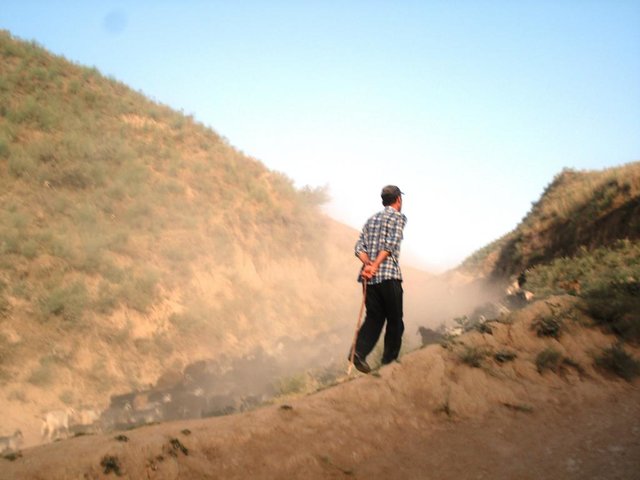
Common village herding [塔吉克斯坦]
Village herding system with daily alternation of the herders including each household in a monthly turnus.
- 编制者: Christian Wirz
2. SLM技术的说明
2.1 技术简介
技术定义:
Rotational grazing on village pastures with heavy pressure with daily to weekly change of grazing places.
2.2 技术的详细说明
说明:
The herding season is from the beginnning of March to the End of Octobre or even beginning of Decembre. Total area is between 10-20 km2, depending on how strictly the borders are understood. Cows, sheep, goats and donkeys compose the herds. Grazing begins when soil moisture begins to decreaset, first with the little animals, that are supposed to better cope with slippery conditions. After two weeks the cows are led to the pastures and in some cases they will be grazed alone, because sheep and goats disturb them. The grazing zone is situated between 1400 and 1700 m. Rotation begins on the lower pastures, at the beginning of summer the higher pastures are used and towards autumn the animals graze near the villages again, sometimes on cropland, feeding on crop residues. The herders are advised to change place after 2-3 days, but often stay in one place for a longer time. The animals are gathered on the way out of the village a little after dawn, than brought to the pastures. At noon-time they will be lead to a shady place close to a stream, if possible. The same places are visited three or more times per season.
Purpose of the Technology: The animals should be nourished and the cows should give milk. A land user kept his cow at home towards the end of summer, because it stopped giving milk, from the sparse and dry vegetation on the pastures.
Establishment / maintenance activities and inputs: The costs for this form of herding are lost days at school for the children. It largely works without external inputs (such as fertilisers). Other inputs such as salt for the animals are covered by the landowner.
Natural / human environment: These pasture-areas are heaviliy suffering from overuse on one hand and from droughts on the other side. They are in a generally well-conserved state. Fractional vegetation cover is low, especially tree cover, and the proportion non-palatable species relatively high. Erosion by water, including gullies, and crusting, are common phenomena, especially in low cover areas.
2.3 技术照片
2.5 已应用该技术的、本评估所涵盖的国家/地区/地点
国家:
塔吉克斯坦
区域/州/省:
Region of Republican Subordination
有关地点的进一步说明:
Faizabad
具体说明该技术的分布:
- 均匀地分布在一个区域
如果不知道精确的区域,请注明大致覆盖的区域:
- 10-100 平方千米
注释:
Total area covered by the SLM Technology is 15 km2.
For some villages figures are available, for instance for Karsang: This village has alltogether 850 ha of common grazing land, for officially 212 cows and 775 little animals. For the whole Jamoat the figures are of around 2500 ha of pasture-land (not all in the study-area) for 2695 cows and 5950 little animals.
Map
×2.6 实施日期
如果不知道确切的年份,请说明大概的日期:
- 50多年前(传统)
2.7 技术介绍
详细说明该技术是如何引入的:
- 作为传统系统的一部分(> 50 年)
注释(项目类型等):
Already before the USSR the villages used to have their hamlets and grazed them around the villages, but also in the formerly not very populated plains. By the settlement of people in the plains and population growth from the 1970ies onward livestock numbers and pressure on natural resources started to increase there. And through Soviet collective agriculture people were forced to keep livestock close to the villages, as a consequence of their employment. In addition, grazing on the territory of forest administration, founded in the 1960ies, was forbidden for the villagers.
3. SLM技术的分类
3.2 应用该技术的当前土地利用类型

牧场
粗放式放牧:
- 经营牧场
动物类型:
- 山羊
- 绵羊
- cow, donkey
注释:
Livestock density (if relevant):
< 1 LU/km2
Major land use problems (compiler’s opinion): Soils are heavily degraded in the sense of generally high levels of compaction and crusting and low organic matter contents. Vegetation is especially reduced in cover, not necessarily in biomass and, the fraction of good pasture species is low.
Major land use problems (land users’ perception): Many trees have been cut down during civil war and till today, leaving back a soil without protection. Animals grazing on these pastures are not fat, often sick and cows give little and sometimes (in summer) no milk. An often mentioned problem is the situation of drought in 2008 and animals staying in one place for longer periods, which leads to degradation of vegetation.
Ranching: sheep and goats / cows and donkeys.
Grazingland comments: In spring sheep and goats are herded before cows, then in a separate herd and toward the end of the season, together.
Type of grazing system comments: In spring sheep and goats are herded before cows, then in a separate herd and toward the end of the season, together.
3.4 供水
该技术所应用土地的供水:
- 雨养
注释:
Specify:
Longest growing period in days: 270Longest growing period from month to month: Oct - Jul
3.5 该技术所属的SLM组
- 畜牧业和牧场管理
3.6 包含该技术的可持续土地管理措施

管理措施
- M1:改变土地使用类型
注释:
Main measures: management measures
3.7 该技术强调的主要土地退化类型

土壤水蚀
- Wt:表土流失/地表侵蚀
- Wg:冲沟侵蚀/沟蚀
- Wm:块体运动/滑坡

生物性退化
- Bc:植被覆盖的减少
注释:
Secondary types of degradation addressed: Wt: loss of topsoil / surface erosion, Wg: gully erosion / gullying, Wm: mass movements / landslides, Bc: reduction of vegetation cover
Main causes of degradation: overgrazing (Big livestock numbers on little surface.), poverty / wealth (People depend on livestock and on cheap pastures.)
Secondary causes of degradation: droughts (Many people mention that rainfalls were much lower in 2007-2008 than normally.), population pressure (Especially from the 1970ies onward population increased rapidly.), land tenure (As long as no-one is really responsible for the are, conservation measures are difficult to implement.), war and conflicts (Civil war was detrimental to the (little) economic, non-agricultural sector (textiles, car-parts) and to the institutions, so that many people had to return to agricultural activities.)
3.8 防止、减少或恢复土地退化
具体数量名该技术与土地退化有关的目标:
- 减少土地退化
注释:
Main goals: mitigation / reduction of land degradation
4. 技术规范、实施活动、投入和成本
4.1 该技术的技术图纸
技术规范(与技术图纸相关):
Rotation of the village herds.
Location: Karsang and other villages. Faizabad
Date: 20.08.09
Technical knowledge required for land users: low (The practiced rotation follows the humour of the herders (often children) and is not complicated.)
Secondary technical functions: improvement of surface structure (crusting, sealing), increase of biomass (quantity)
Change of land use practices / intensity level: The begin of grazing and the rotation is fixed by a village committee. Animals should not stay at one place for longer than 3 days.
作者:
Christian Wirz, Switzerland
4.2 有关投入和成本计算的一般信息
其它/国家货币(具体说明):
Somoni
如相关,注明美元与当地货币的汇率(例如1美元=79.9巴西雷亚尔):1美元=:
3.42
4.3 技术建立活动
| 活动 | 时间(季度) | |
|---|---|---|
| 1. | Villagers buy animals, usually 6-10 goats and / or sheep, 1-2 cows and / or donkeys. | Constantly size is regulated. |
4.4 技术建立所需要的费用和投入
| 对投入进行具体说明 | 单位 | 数量 | 单位成本 | 每项投入的总成本 | 土地使用者承担的成本% | |
|---|---|---|---|---|---|---|
| 其它 | buy the animals | per year | 1.0 | 1170.0 | 1170.0 | 100.0 |
| 技术建立所需总成本 | 1170.0 | |||||
| 技术建立总成本,美元 | 342.11 | |||||
4.5 维护/经常性活动
| 活动 | 时间/频率 | |
|---|---|---|
| 1. | Per capita fee taxes | Once per year. |
| 2. | Buying concentrated feed, depending on the financial resources of the land user. | Bought once per year, for winter period. |
| 3. | Haymaking and / or buying, depending on labour, financial resources and livestock numbers. | June-July, respectively later, if bought. |
| 4. | Medecine and salt for animals | Irregularly, resp. daily to weekly. |
4.6 维护/经常性活动所需要的费用和投入(每年)
| 对投入进行具体说明 | 单位 | 数量 | 单位成本 | 每项投入的总成本 | 土地使用者承担的成本% | |
|---|---|---|---|---|---|---|
| 其它 | Per capita fee taxes | per year | 12.0 | 1.0 | 12.0 | |
| 其它 | Buying concentrated feed | kg | 425.0 | 0.53 | 225.25 | |
| 其它 | Medecine and salt for the animals | for all animals | 1.0 | 45.0 | 45.0 | |
| 技术维护所需总成本 | 282.25 | |||||
| 技术维护总成本,美元 | 82.53 | |||||
注释:
The calculated costs apply to each land user's cost for this herding system.
4.7 影响成本的最重要因素
描述影响成本的最决定性因素:
The most important cost factor is buying livestock. Recurrent costs are low, but rent fees for pastures are percieved as being high.
5. 自然和人文环境
5.1 气候
年降雨量
- < 250毫米
- 251-500毫米
- 501-750毫米
- 751-1,000毫米
- 1,001-1,500毫米
- 1,501-2,000毫米
- 2,001-3,000毫米
- 3,001-4,000毫米
- > 4,000毫米
农业气候带
- 半干旱
Thermal climate class: subtropics
5.2 地形
平均坡度:
- 水平(0-2%)
- 缓降(3-5%)
- 平缓(6-10%)
- 滚坡(11-15%)
- 崎岖(16-30%)
- 陡峭(31-60%)
- 非常陡峭(>60%)
地形:
- 高原/平原
- 山脊
- 山坡
- 山地斜坡
- 麓坡
- 谷底
垂直分布带:
- 0-100 m a.s.l.
- 101-500 m a.s.l.
- 501-1,000 m a.s.l.
- 1,001-1,500 m a.s.l.
- 1,501-2,000 m a.s.l.
- 2,001-2,500 m a.s.l.
- 2,501-3,000 m a.s.l.
- 3,001-4,000 m a.s.l.
- > 4,000 m a.s.l.
关于地形的注释和进一步规范:
Altidudinal zone: Most pastures are close to the villages, on around 1300-1500 m, but some pastures reach altitudes of 1600-1700 m.
Landforms: The pasture-areas usually follow N-S-ridges and most pastures are in slope-areas.
Slopes on average: Also hilly
5.3 土壤
平均土层深度:
- 非常浅(0-20厘米)
- 浅(21-50厘米)
- 中等深度(51-80厘米)
- 深(81-120厘米)
- 非常深(> 120厘米)
土壤质地(表土):
- 中粒(壤土、粉土)
表土有机质:
- 低(<1%)
如有可能,附上完整的土壤描述或具体说明可用的信息,例如土壤类型、土壤酸碱度、阳离子交换能力、氮、盐度等。:
Soil texture (topsoil): Loess soils
Soil fertility low: In most places high proportions of non-graminoids and leguminous species.
Topsoil organic matter: High proportion of hot-spots and degrading areas according to Wolfgramm's (2007) hot-brightspot-map.
Soil drainage / infiltration poor: Most soils are crusted and compacted.
5.4 水资源可用性和质量
地下水位表:
> 50米
地表水的可用性:
匮乏/没有
水质(未处理):
不良饮用水(需要处理)
关于水质和水量的注释和进一步规范:
Ground water table: Often no groundwater, because too hilly
Availability of surface water: Most areas far from open water bodies
Water quality (untreated): No pesticides, but water is contaminated by animal dung.
5.5 生物多样性
物种多样性:
- 低
关于生物多样性的注释和进一步规范:
In comparison with other areas.
5.6 应用该技术的土地使用者的特征
生产系统的市场定位:
- 生计(自给)
- 商业/市场
非农收入:
- > 收入的50%
相对财富水平:
- 平均水平
个人或集体:
- 个人/家庭
性别:
- 女人
- 男人
说明土地使用者的其他有关特征:
Land users applying the Technology are mainly common / average land users
Difference in the involvement of women and men: Many children are working as herders, because of labour shortage (young men in Russia).
Population density: < 10 persons/km2
Annual population growth: 1% - 2%
30% of the land users are rich (People who have a house made of concrete or with a ribbed roof instead of one made of cement asbesto).
70% of the land users are average wealthy (Compared to the rest of society: People have enough food, children go to school, they have a mud-hou).
Off-farm income specification: Nearly all people have family members (mostly sons) in Russia, who send remittances.
Market orientation of production system subsistence (self-supply): Animals are mainly used for own consumption (meat and milk).
Market orientation of production system commercial / market: Animals are sold, if the family needs money (for medecine or education).
So, it is still better from their perspective to have animals ("as a bank", according to many villagers), than not having this security. And it is comparatively cheap, even if a land user admits that he has to feed his cow with leaves of his muleberry trees, because pastures are so unproductive, that his cow does not give milk anymore (in August).
5.7 应用该技术的土地使用者使用的平均土地面积
- < 0.5 公顷
- 0.5-1 公顷
- 1-2 公顷
- 2-5公顷
- 5-15公顷
- 15-50公顷
- 50-100公顷
- 100-500公顷
- 500-1,000公顷
- 1,000-10,000公顷
- > 10,000公顷
这被认为是小规模、中规模还是大规模的(参照当地实际情况)?:
- 小规模的
注释:
Average area of land owned or leased by land users applying the Technology 2-5 ha: This corresponds to the average for the whole study-area, including haymaking areas.
Average area of land owned or leased by land users applying the Technology 5-15 ha: Households having a farmer's association mostly have more than the average.
Average area of land owned or leased by land users applying the Technology 15-50 ha: Some rich families even have more land that they rent to others.
5.8 土地所有权、土地使用权和水使用权
土地所有权:
- 州
土地使用权:
- 自由进入(无组织)
- 社区(有组织)
注释:
Pasture-use is theoretically regulated as described above, but additionally to the village herd there are other herders with private animals using the same pastures.
5.9 进入服务和基础设施的通道
健康:
- 贫瘠
- 适度的
- 好
教育:
- 贫瘠
- 适度的
- 好
技术援助:
- 贫瘠
- 适度的
- 好
就业(例如非农):
- 贫瘠
- 适度的
- 好
市场:
- 贫瘠
- 适度的
- 好
能源:
- 贫瘠
- 适度的
- 好
道路和交通:
- 贫瘠
- 适度的
- 好
饮用水和卫生设施:
- 贫瘠
- 适度的
- 好
金融服务:
- 贫瘠
- 适度的
- 好
6. 影响和结论性说明
6.1 该技术的现场影响
社会经济效应
生产
饲料质量
注释/具体说明:
Compared with all other areas the proportion of forbs is very high.
畜牧生产
注释/具体说明:
Compared with an efficient grazing rotation, returns (in terms of milk and meat) are very low.
木材生产
注释/具体说明:
Very little trees are left because of goats eating them.
产品多样性
注释/具体说明:
During war most people depended on cropland (wheat).
收入和成本
工作量
注释/具体说明:
This system does not depend on professional herders, is thus economic, also in financial terms.
社会文化影响
食品安全/自给自足
注释/具体说明:
It is better for land users to have communal pastures but worse than having a well-implemented rotational grazing system, but the family does not have to buy meat.
社区机构
Livelihoods and human well-being
生态影响
水循环/径流
地表径流
注释/具体说明:
Especially trampling paths of livestock are very vulnerable to water erosion
土壤
土壤结壳/密封
注释/具体说明:
The degree of compaction is higher than elsewhere.
土壤压实
注释/具体说明:
The degree of compaction is higher than elsewhere.
土壤有机物/地下C
注释/具体说明:
Organic matter is very low compared with all other areas. Biomass might be stonger reduced with animals grazing earlier in spring.
生物多样性:植被、动物
生物量/地上C
6.3 技术对渐变气候以及与气候相关的极端情况/灾害的暴露和敏感性(土地使用者认为的极端情况/灾害)
气候有关的极端情况(灾害)
气象灾害
| 该技术是如何应对的? | |
|---|---|
| 局地暴雨 | 不好 |
气候灾害
| 该技术是如何应对的? | |
|---|---|
| 干旱 | 不好 |
注释:
Pasture areas, that remain the same since the USSR, could be changed every few years to permit their recovery and regrowth of trees, chopped during and after civil war. The very basic rotational schemes existing in all villages are little effective. It is not possible to recognise conservation effects due to the generally very critical state of resources.
6.4 成本效益分析
技术收益与技术建立成本相比如何(从土地使用者的角度看)?
短期回报:
积极
长期回报:
稍微积极
技术收益与技术维护成本/经常性成本相比如何(从土地使用者的角度看)?
短期回报:
积极
长期回报:
稍微积极
注释:
The land users see the problem of reduced productivity when pastures are overexploited. They complain about having to sell animals, but mainly attribute this to droughts.
6.5 技术采用
如若可行,进行量化(住户数量和/或覆盖面积):
NA
在所有采用这项技术的人当中,有多少人是自发的,即未获得任何物质奖励/付款?:
- 91-100%
注释:
Comments on acceptance with external material support: No subsidies have been paid for buying livestock. But, as people highly depend on remittances, it can be assumed that these have also been invested into livestock.
100% of land user families have adopted the Technology without any external material support
There is a moderate trend towards spontaneous adoption of the Technology
Comments on adoption trend: Young families who do not yet have livestock are thinking of buying animals in the future. On the other hand herding in the upper areas still has potential and wealthy people might want to send their animals there with professional herders in the future.
6.7 该技术的优点/长处/机会
| 土地使用者眼中的长处/优势/机会 |
|---|
|
Animal husbandry is an economic basis which permits development. How can they be sustained / enhanced? People should be allowed to keep as much animals as they want to. And the pasture-area should not become smaller. |
| 编制者或其他关键资源人员认为的长处/优势/机会 |
|---|
|
It is the most cheap form of self-sufficient meat-production. How can they be sustained / enhanced? Pasture-quality needs to be preserved, otherwise the carrying-capacity of pastures will be reduced. |
|
Livestock with its semimonetary value is much more stable in value than money on the bank (increasing livestock prices). How can they be sustained / enhanced? Only if alternatives for animal husbandry emerge will the prices for livestock not fall. |
6.8 技术的弱点/缺点/风险及其克服方法
| 土地使用者认为的弱点/缺点/风险 | 如何克服它们? |
|---|---|
| Animals and pastures are less productive (reduced biomass) and pastures show more signs of erosion than those on forest department. There, pasture-areas are bigger and, by consequence, there is more space for herding. | If there were not always more people affording to rent land for orchards or haymaking the pressure on the remaining pastures would not increase. |
| The pastures very much depend on enough water: If there is little rain (like in 2008) animals return hungry from the pastures. | There is hope that the planned water pipe from Rogun (planned giant dam) will bring water for irrigation (of cropland, where animals graze in late summer and where forbs are collected as winter fodder). |
| Rent fees have to be paid, which are percieved as high by some land users. They fear additional per-capita animal taxes. | No more taxes should be introduced and herding should not be stronger regulated, because many people depend on animal husbandry. |
| This herding system is vulnerable to droughts and temperature increase, which are percieved as main degradation causes. Besides this, excessive livestock numbers are seen as a cause of cover reduction and compaction. Especially where animals graze the soil is naked and dry after 2-3 days. | It might be helpful to let the pastures recover for 3-5 years for trees (which bring moisture) to grow. But this might require administration through external institutions and people fear that they will not get back the pastures. |
| 编制者或其他关键资源人员认为的弱点/缺点/风险 | 如何克服它们? |
|---|---|
| Degradation of soils and vegetation on these relatively small areas is high and the pastures cannot recuperate due to constant pressure. | The pastures need to have periods of recovery. |
| The soils are decreasing in fertility because animal dung is used as energy source. | A not too expensive alternative for hot water might be solar heaters or charcoal. And to counteract general fertility problems interchanging pasture- and haymaking areas would bring dung everywhere. But this would require fencing of the remaining trees in order not to further damage vegetation cover. |
7. 参考和链接
7.1 信息的方法/来源
链接和模块
全部展开 全部收起链接

Common village herding [塔吉克斯坦]
Village herding system with daily alternation of the herders including each household in a monthly turnus.
- 编制者: Christian Wirz
模块
无模块


